Era: 1830 - 1840s Cultural background: Irish Collection: Liverpool Theme:Agriculture Archaeology Convicts Folk Art Macquarie Settlement

Wheat Sheaf Gatepost. Photograph Daniela Ristevsk
Collection
Liverpool Regional Museum, Liverpool, Australia.
Object Name
Wheat Sheaf Gatepost.
Object Description
Sandstone sculptured wheat sheaf on top of a green painted sand stone plinth that has the painted inscription “Macquarie Fields”. Dimensions: approximately 500mm long X 120mm wide x 120mm deep.
When England lost its American colonies in 1778 in the American War of Independence, it began to look to the Pacific to replace these markets and resources. Joseph Banks, an influential naturalist and merchant, convinced the British government that breadfruit from Tahiti was an ideal crop to grow in the West Indies and use to feed slaves. Banks also argued that Botany Bay in New South Wales would make an ideal British port in the Pacific and that a settlement should be established with indentured convict labour. A penal settlement was also seen as a possible solution to the increasing problem of petty crime and a growing prison population in English cities.
These problems were compounded by massive unemployment due to the ‘Industrial Revolution’. Food and materials once supplied from farms across the British Isles were now replaced by imports that were processed in mills and factories. British farm owners turned their land over to sheep grazing. They evicted farm labourers and their families, who, with no jobs and nowhere to live, flocked to the cities looking for work in the mills. Many resorted to petty crime to feed their families and indeed petty crime became a way of life for many. Criminality was widespread because it was hard to catch criminals in the warren like streets of the industrial cities and there was not a dedicated professional police force. Despite this the few gaols there were started to fill up and a solution to the crime problem was sought.
Despite it being a huge and very expensive experiment to set up a colony in an unknown land on the other side of the world, Britain decided to establish a penal colony at Botany Bay under the leadership of Captain Arthur Phillip. This was hoped to replace convict dumping grounds lost in North America, clear out the British gaols, provide a deterrent to crime in Britain and establish a deep water port in the South Pacific for Britain to expand its territories.
The First Fleet of 11 ships, each one no larger than a Manly ferry, left Portsmouth in 1787 with more than 1480 men, women and children onboard. Although most were British, there were also Jewish, African, American and French convicts from Britain. After a voyage of three months the First Fleet arrived at Botany Bay on 24 January 1788. Here the Aboriginal people, who had lived in isolation for 40,000 years, met the British in an uneasy stand off at what is now known as Frenchmans Beach at La Perouse. On 26 January two French frigates of the Lapérouse expedition sailed into Botany Bay as the British were relocating to Sydney Cove in Port Jackson. The isolation of the Aboriginal people in Australia had finished. European Australia was established in a simple ceremony at Sydney Cove on 26 January 1788.
Between 1789 and 1791, the settlers at Sydney Cove were critically short of food. To make matters worse, the supply ship Guardian was wrecked off South Africa before it reached the Colony, and HMS Sirius , one of two of the Colony’s Navy vessels, was wrecked on Norfolk Island en route to China seeking food. In desperation, the HMS Supply, the Colony’s second Navy ship was sent to Indonesia for food. Hopes were raised when a vessel arrived in Port Jackson in 1790, but it was not the Supply , but the Second Fleet of five ships carrying over 730 people. This Second Fleet was a disaster, with its human cargo severely abused and exploited by the private ship owners. Of 1000 convicts on board, 267 died and 480 were sick from scurvy, dysentery and fever. The supplies on board the Second Fleet were supposed to feed the convicts, but the ship owners withheld the supplies for sale until after the convicts disembarked. Phillip, enraged by this behaviour as he had to further ration existing supplies, became desperate to establish farms and a local economy.
Farms, established with convict labour at Rose Hill ( Parramatta ) and later at Richmond and Windsor, were soon producing crops. Explorers set out to find new land and areas were opened up in the Liverpool area for market gardens, viticulture and sheep grazing for wool. These farms and pastures all depended on an abundant source of free convict labour to survive. Convicts were assigned to farmers under strict conditions known as the Assignment System.
Liverpool was the first of many towns founded by Governor Macquarie in 1816. He wanted to move the colony’s main food-growing region away from the flood-prone Hawkesbury area. He reserved 60-100 acre parcels of the rich soil of Airds and Appin for small farmers. The rest of the land was given out in several hundred acre lots to wealthy former soldiers and public servants. With rare exceptions Macquarie would not give land to women.
In the 1830s Liverpool had become a trading centre for the whole South West Sydney area. Some farmers and merchants made their fortunes and engaged the colony’s leading architects to build them grand houses. Liverpool also acted as a centre for the management of large numbers of convicts. They were employed by local settlers and by the government. Free tradesmen were encouraged to come to build in Liverpool by being given blocks of land in the town. The growing township and migration of Europeans to the area had a tremendous impact on the local environment and the aboriginal people.
The traditional owners of the Macquarie Fields area were the Darug people of western Sydney. The rich soil of the area was home to an abundance of plants which in turn attracted animals such as kangaroos and emus, both of which along with yams and other native vegetables and fruit were part of the diet of the Darug. They lived in small huts called gunyahs, made spears, tomahawks and boomerangs for hunting and had an elaborate system of tribal law and rituals with its origins in the Dreamtime. However, following the arrival of the First Fleet in 1788, they were pushed off their land by the British settlers.
Fortunes were to be made from wool and wheat grown on big properties. In 1839, Christiana Brook’s daughter, Christiana Bloomfield, wrote that their income at Denham Court came from selling wool to England and sheep and cattle to local markets for meat. But by 1840 Liverpool ‘s graziers had moved in search of even more profits, to bigger properties beyond the Cumberland Plain. They took Liverpool ‘s prosperity with them 1.
One of these properties was Maquairefield (sic) House established by James Meehan, like other pardoned convicts, worked closely with the Governor, Lachlan Macquarie. He settled at Ingleburn and out of gratitude, or flattery, called his property Macquariefield.
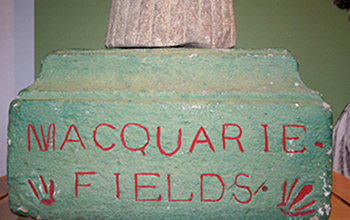
Wheat Sheaf Gatepost. Photograph Daniela Ristevski
The wheat sheaf sculpture has long been associated with the gatepost stone plinth of Macquarie Field estate. It is possible that this stone dates from Macquarie Fields House built by Samuel Terry. Terry took over Meehan’s property to settle his debts. Terry built a new house at Macquarie Fields for his daughter Martha in 1838.
Meehan was sent to New South Wales as a convict after taking a minor role in the Irish rebellion of 1798. As he had been a teacher and surveyor in Ireland, he was appointed as an assistant to Charles Grimes, the New South Wales Surveyor-General.
In June 1805, Governor King awarded Meehan a conditional pardon for his services. This was upgraded to a full pardon in June 1806. Governor Macquarie appointed Meehan as Acting Surveyor-General in 1810.
Meehan acquired several grants of land around Sydney and the Southern Highlands during his period of work with the Government, but two significant grants together became the 2020 acres known as Macquarie Field. A huge farm, it covered much of modern Macquarie Fields and Glenfield, and as far west as Denham Court.
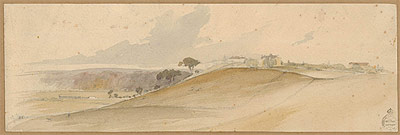
Macquarie Fields, c.1850s, Courtesy State Library of New South Wales
Meehan, a strong supporter of Governor Macquarie, named the property after his friend and benefactor. But the early brick home he built was soon nicknamed Meehan’s Castle by local farmers.
Meehan rarely had time to enjoy his home and spent more time surveying than at the property. The Reverend Thomas Reddall ran a boarding school for young upper-class boys at the house for many years.
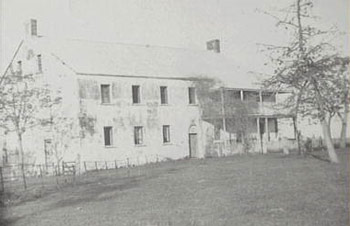
Meehan’s Castle which combined a schoolhouse on the left and James Meehan’s barn on the right. Courtesy of Campbelltown City Library
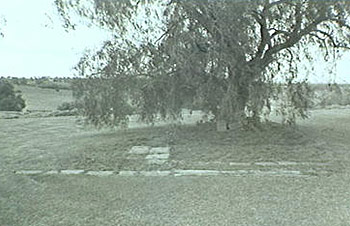
Remains of Meehan’s Castle, c.1985. Courtesy of Campbelltown City Library
After his retirement in 1822, Meehan was able to dedicate himself to his farm. He grew wheat, barley, maize and vegetables, planted a huge orchard, and raised live-stock. When he died in 1826, the whole estate was inherited by his only child, 18-year-old Thomas Meehan.
Thomas married an Appin woman, Mary Ann Tress, but he was too young and inexperienced to handle the management of Macquarie Field – or the debts left by his father.
Three years before his death, James Meehan had taken a mortgage from Samuel Terry for 1414 Pounds. By Thomas Meehan’s 21st birthday in 1829, the creditors at his door and between 1829 and 1835 he lost all the family properties, including Macquarie Field, which he sold to Samuel Terry.
His wife, Mary Ann, by now suffering mental illness, was admitted to Liverpool Asylum, her condition attributed by Thomas to the pressures from Terry.
Thomas, who had slipped from gentlemen farmer to salaried postmaster at Campbelltown, fell ill and in July 1835 committed suicide.
Samuel Terry himself died in 1838, leaving the old Meehan grant to his daughter, Martha, for whom it’s believed Macquarie Field House was built in the 1830s. Much of the estate was divided into small farms, while Martha made her home in the hilltop mansion with husband, John Hosking, and their children.
For much of the 1860s, the house was used as a private school, although it remained in Martha’s ownership until her death in 1877. The house and western part of the estate were sold to the Ashcroft family, but land east of the railway was put up for sale in 1881.
In 1883, then owner William Phillips subdivided the land to create a new town he called Glenwood Estate with grand boulevards and fine buildings. A railway station was added to the line in 1888 but the depression of the 1890s meant the grand town failed to materialise with only a few small houses built on the lots. In the next Great Depression of the 1930s, the area became popular with the homeless who established an unemployment camp.
After World War II, the village grew steadily. A public school was opened in 1958 and by 1971, the population reached 3700. Around this time, a large Housing Commission development was built on the east side of town. This led to a huge population growth and there was even talk of splitting the suburb in two with the newer Housing Commission area taking the name Glenwood but opposition to the proposal put an end to that idea. Private housing developments sprung up further around and the weight of population contributed to a larger town centre.
Macquarie Fields gained notoriety as the location of riots in 2005. Allegations were made that these were the result of the Housing Commission area being something of a ghetto. Since then, there has been a move to sell or demolish many of those houses, moves which are resisted by tenants, some of whom have lived there for thirty years or more.
Macquarie Fields House fell into disrepair and was extensively run down by the 1930s. Macquarie Fields House was carefully restored by David Jamison in 1962 and is now in good condition. Mr. Jamison sold the house to Scots College in 1993. It is now listed on the Register of the National Estate.
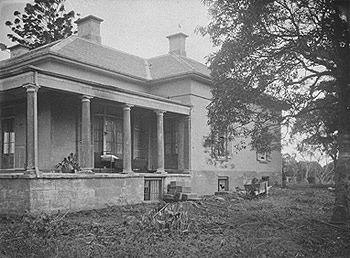
Macquarie Fields House, c.1920s. Courtesy Mitchell Library, State Library of New South Wales
The wheat sheaf gatepost has historical significance as evidence of the colonial expansion out of Port Jackson onto the Liverpool plains and the establishment of the Macquarie town of Liverpool. The object has historical significance as evidence of colonial building materials and practices. The object has historical significance as evidence of the introduction of European law, agriculture and culture that resulted in the dispossession of the Aboriginal people.

Wheat Sheaf Gatepost detail. Photograph Daniela Ristevski
The wheat sheaf gatepost has aesthetic significance in the manufacture of early building materials especially hand stone masonry and stone cutting.
The wheat sheaf gatepost is significant for researchers as it relates to a specific early colonial significant site in the Liverpool area.
The wheat sheaf gatepost has intangible significance being iconic symbols of Australia ‘s brutal convict origins, the development of the early settlement at Port Jackson and Liverpool and the development of intense agriculture.
The wheat sheaf gatepost is provenanced to Macquarie Fields House and was acquired by the Liverpool Regional Museum in the 1990s.
The wheat sheaf gatepost interprets the exploration and expansion of the early colony at New South Wales. It also interprets the change from the brutal convict origins of European Australia to a migrant based market based economy. The collection has the potential to interpret the building methods used by Greenway and other of the time in the construction of many of the early building in Sydney.
Footnotes
Bibliography
Coupe, S & Andrews, M, Their Ghosts may be heard: Australia to 1900 , Longman Cheshire, Sydney.
Hughes, R 1987, Fatal Shore , London.
Stories of Liverpool: 1788 – 1900 Teacher’s Notes , Liverpool Regional Museum.
Stories of Liverpool: 1788 – 1900 Education Kit , Liverpool Regional Museum.
Heritage Collections Council 2001, Significance: A guide to assessing the significance of cultural heritage objects and collections, Canberra.
Websites
www.campbelltown.nsw.gov.au/default.asp?
iDocID=2118&iNavCatID=322&iSubCatID=1382
Migration Heritage Centre
January 2008 – updated 2011
Crown copyright 2008 ©
The Migration Heritage Centre at the Powerhouse Museum is a NSW Government initiative supported by the Community Relations Commission.
www.migrationheritage.nsw.gov.au
Regional Services at the Powerhouse Museum is supported by Movable Heritage, NSW funding from the NSW Ministry for the Arts.
Liverpool Regional Museum is managed by Casula Powerhouse.
www.casulapowerhouse.com




